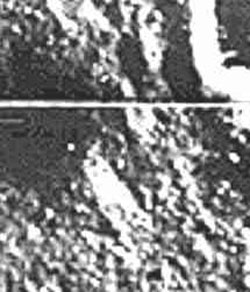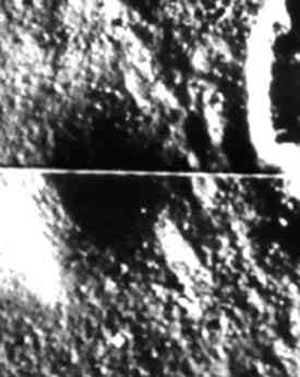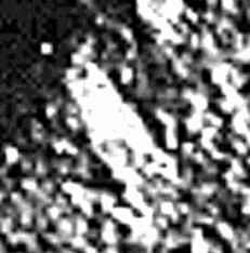|
Analysis of LO-III-164-H2
Figure 3 Analysis
Now that new information
has become available, I can finally resolve many of the issues raised
originally many months ago regarding this frame. However, the "Overpass"
(see far below) appears to be a genuine raised structure without a
satisfactory natural explanation.
Figure 3 appears to be fairly mundane impact crater. Yet, a number of
unusual if not outright strange features adorn this frame. The sun
appears to be coming from the high right, but I cannot confirm this as
my copy of the Lunar Orbiter data is unreadable. The location is 1
degree, 40 minutes N, 42 degrees 20 minutes W.
The "double ring" nature of this crater is not a common
sight for Lunar impact craters. In fact, it may be unprecedented. The
center of the crater also has some very bright spots in the shadowed
portion, which may indicate a structure of some kind in the bowl.
The left to right "graining" of the film strips is quite obvious, but
a bright "scratch" on the far right of the picture, running almost
vertical (in the frame) is less easily dismissible. It seems to
actually pass through several "nubs" on the Lunar surface, rather than
obscure them underneath, as it would if it were an actual emulsion
scratch. The fact that it passes almost directly through the center of
a number of these "nubs", and seems to terminate at anchor points,
like a massive clothes line, also warranted closer scrutiny. However,
the negative I received from NSSDC did not have this
feature, and I must conclude it is a scratch or deliberately etched
line.
In addition, several craters in the lower center of the frame form a
nearly perfect triangular formation, one made up of three points, the
other of 5. The craters on Burgess' version have a distinctly
hexagonal shape, and they retain this on my version (see below). The
significance of this shape remains debatable.
The most intriguing object on this frame is the "Overpass":
|
The "Overpass"
,from Burgess' LO-III-167-H2 |
... and from
my LO-III-164-H2 |
|
 |
 |
Located adjacent to the large double crater in the center of Fig. 3
(above top), this object has the appearance of an Overpass
or trestle, perhaps once traversing the the shallow depression it
overhangs. Clearly reflecting a lot of sunlight, it blots out the
rocky terrain below and has a box-like, "stepped" construction ...
|
Burgess version.
|
Bara version. |
 |
 |
The "squaring" of the steps may be due to image compression in the "Burgess
version", but it certainly has the appearance of a staircase
of some sort. The object is probably about 2-3 stories high, and is
not likely to have been caused by debris from the crater formation or
volcanic action. It is a "spike" standing up over the edge of the
crater where it should not be. Unfortunately, it is not likely this
object has been photographed in any other NASA frames,
and it is far too small to resolve with Clementine's instruments.
|